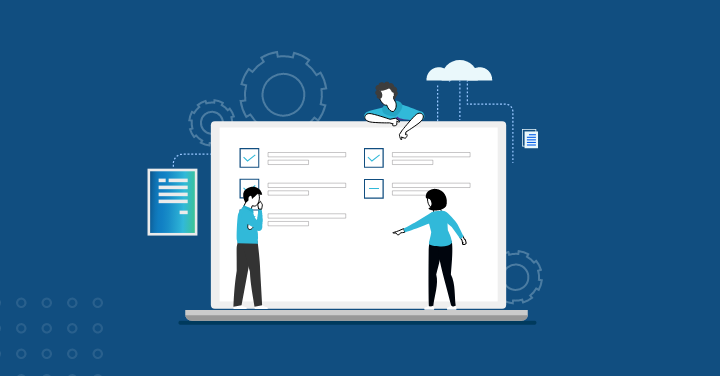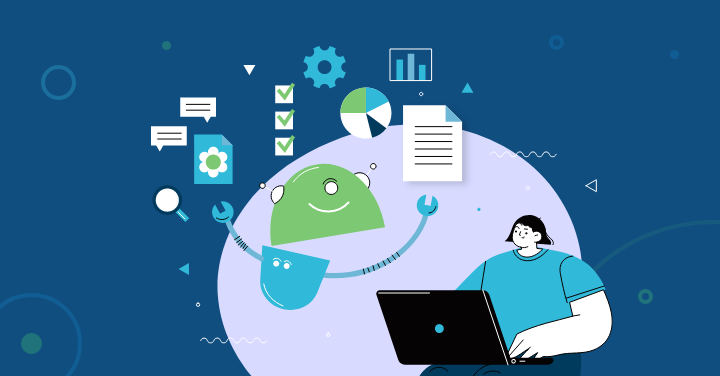Technology and social media have become so important in our daily lives that we can’t imagine living without them. Everywhere we go, everyone has their faces stuck to their phones.
But sometimes our phones can show any sort of malfunction or get hung up for no reason. In such a situation, you might try to get help from any help desk support system. In recent years, specifically after the rise of AI, many complex IT-driven problems have been solved within minutes with the help of AI.
This article will dive deep into AI’s role in IT desk automation and how it helps reduce ticket resolution time.
Introduction
AI and automation are advancing rapidly, affecting many areas of our lives, including IT. More businesses are now using AI and automation tools in their daily work.
AI and automation have become essential parts of how IT teams operate worldwide. Our recent study shows that over one-third of managers use AI every day.
With new technology, finding the right balance between trying new things and keeping systems stable is essential. Not every new feature is worth the disruption it might cause. Too much change can lead to confusion and disorder.
What is IT Helpdesk Automation?
IT Helpdesk automation is a system where software and technology are used to automate the support process in any company or firm. This helps both the employees and customers of the company, as it saves a lot of time and money and reduces any chances of creating an error.
Support agents are saved from manual work and can use their skills elsewhere to do any other job in which AI cannot be used.
This work is usually done by assigning tickets, sending notifications, and sorting issues; your team can focus on more important work. This saves money and reduces errors, making the support process more efficient.
The evolution of IT help desks and the role of AI
IT service desks have changed a lot over time. They started as physical locations where people went to get help with computer problems. These early service desks mainly fixed issues as they happened and had limited tools, which made helping people slower.
When the internet became popular, the old way of running IT service desks didn’t work either. People needed faster help and better ways to solve their problems.
Today, technology like AI has completely changed how IT service desks work. New software and intelligent assistants like Siri and Alexa can handle many tasks that the IT staff used to do. This lets IT workers focus on more critical jobs instead of repetitive tasks.
How AI changes IT help desk operations and reduces the ticket Resolution time
Now, let’s look at how AI changes the help desk operations for many professionals and companies.
1. Chat Support
24/7 chatbots can help users solve IT issues. These chatbots can provide step-by-step guides, password resets, and software installation.
One good thing about chat support is that it is always available, even outside service desk hours, so if someone wants to ask something at 3 in the morning, chat support is always there to help.
2. Knowledge Management
AI helps in creating help articles from successful ticket solutions. It continuously updates existing articles on a website to keep the information relevant and up-to-date.
This is useful for IT support teams and a content creators responsible for technical documentation, ensuring that the latest solutions and best practices are always available for users.
3. Virtual Assistance
AI helps service staff by suggesting solutions and offering quick access to knowledge and automated fixes. It also speeds up problem-solving with great features like one-click server restarts.
4. Smart Ticket Handling
Ticket handling involves combining your customers’ issues and problems, which automatically sorts and classifies incoming requests. AI summarizes the tickets for easier reading and solves common problems automatically.
5. AI Camera for IT Support
AI-driven cameras are now being used in IT service desks to enhance automation. An AI camera can detect physical hardware issues in devices, such as broken ports, loose connections, or overheating components.
IT support teams can use AI cameras for real-time monitoring, ensuring workplace IT equipment functions properly. This technology helps diagnose problems faster, reducing downtime and improving overall efficiency.
6. Communication and Reporting
AI creates service desk announcements and alerts to notify individuals of any update and generates performance reports. Manually collecting data can be complicated and time-consuming, but even in this case, AI already predicts future trends using past data while also suggesting improvements.
7. Other Support Features
AI help desk tools offer many other features, like finding the experts to solve complex problems, monitoring devices, and spotting issues so they can be quickly resolved. Other than that, it also suggests preventive maintenance.
Improving customer experience with AI in IT helps desk automation
In today’s fast-moving online world, businesses must keep changing to keep customers happy. AI is changing how companies work with their customers. AI tools are making customer service faster and better.
- Better Service and Support: AI helps businesses predict and solve customer problems before they become issues. By looking at past data, AI can spot and fix common problems early, making customers happier. It stops problems early by spotting issues before customers complain and gives faster and better customer support that makes customers trust the business more.
- Personal Touch for Every Customer: AI helps to create custom experiences for each customer by understanding their likes and habits. This means customers get suggestions and messages that match their interests. AI tries to generate more sales from better-matched suggestions, making the customers return or rebuy the products. Improving marketing efforts gets customers more involved with the business, which makes marketing work better by reaching out to the right people at the right time.
- Saving Time with Automation: AI handles simple tasks like answering common questions and processing payments. This frees up staff to help with more complex customer needs. It helps save money by reducing staff needs and giving customers quick answers by handling many customers simultaneously.
Benefits of using AI in the IT help desk industry
There are many benefits of using AI in IT help desks. Here are some of these below:
- Mood Detection: AI spots when users are frustrated or need urgent help, allowing faster and more caring responses.
- Automatic Fixes: AI independently finds and fixes minor IT problems, keeping systems running smoothly.
- Smart Help Guides: AI keeps help articles up-to-date based on new support requests, making self-help easier. It remembers past conversations to give solutions for each user, avoiding repeat questions.
- Rule Checking: AI ensures IT work follows company and industry rules to avoid breaking regulations.
- Problem Prevention: AI suggests fixes before users need to ask for help, reducing work for IT teams.
- Language Help: AI chatbots can help users in different languages, making support available to everyone.
- Better Planning: AI helps IT teams use their time and resources wisely by studying support patterns.
- Voice Control: Users can get IT help by speaking commands to an AI assistant, which quickly connects IT staff with experts and helpful information to solve complex problems.
Challenges faced with AI in it helpdesk automation
While we talk about the benefits and advantages of how the use of AI has been a decision in the IT service desk industry, we also have to understand there are certain disadvantages of AI. Here are some of them:
1. Working with old computer systems:
Older company systems don’t work well with the new AI tools, making AI work with different software and security systems difficult. Even though modern companies usually don’t use old computers, it is still a limitation, as in such situations, AI can’t be used in places like government administrations.
2. Getting people to use and trust AI
Workers might not want to use AI as it might cause them to lose their jobs. It can also be because of a bad experience in the past that they might not want to use AI.
3. Supporting different ways to communicate
AI must work well with email, chat, phone, and ticket systems. Supporting different languages from countries other than English can be tricky.
Even with these challenges, AI is improving with each passing year, enhancing new features now and then. We expect these features to improve and be solved very soon.
Improving Cybersecurity in IT helpdesks with AI
As security threats grow worldwide and skilled workers become more challenging to find, making systems secure must come first before any tech or AI changes happen.
AI can help protect organizations by finding threats faster, defending automatically, keeping data safe, and making security work smoother. But while we use AI for protection, we also need to ensure that the AI is secure and reliable.
We can help solve the shortage of security experts by using AI to assist with training and updating certifications to match what companies need. The government and businesses can help people understand and use technology safely. These steps build a strong base for lasting progress in technology.
To handle these challenges well, organizations should begin taking specific actions now.
How AI Reduces Human Error
AI helps prevent mistakes by doing repetitive work automatically and consistently. It makes fewer errors than humans when handling data and makes fair decisions based on facts. AI can spot potential problems early by analyzing data, helping to prevent issues before they happen.
As AI systems learn from experience, they improve their tasks and make fewer mistakes. In manufacturing, AI is very good at finding product defects, which leads to better-quality products.
AI also helps protect computer systems by catching fraud and security risks that humans might miss. These benefits make work more efficient and reliable across many businesses.
Ai vs traditional helpdesk: A comparative look at the outcome
1. Expandability: AI chatbots can talk to many customers simultaneously, unlike human agents, who can only handle one conversation simultaneously. This makes chatbots perfect for busy businesses with lots of customer questions.
For the best results, we suggest using a premium server. With human support, customers often wait longer during busy times because there aren’t enough staff.
2. Accessibility: AI chatbots work all day and night, answering questions right away no matter when customers ask. Human support teams usually only work during business hours, so customers might have to wait until the next day for help.
3. Regularity: AI chatbots always give the same quality of service and don’t get tired or moody. While human agents are good at understanding feelings and solving tricky problems, their service can change based on their experience or how they feel that day.
4. Finding answers to perplexing questions: Human agents are better at handling sensitive issues or complicated problems that need understanding and care. While AI chatbots can handle some complex questions, they might struggle with emotional situations or difficult issues that humans handle better.
5. Reduction of expenses: AI chatbots cost more upfront but are cheaper to run over time. Once set up, they need little ongoing investment. Human support teams cost more because businesses must keep paying for salaries, training, and other resources.
Future Trends and AI’s evolving role in the IT helpdesk industry
Artificial intelligence overall has a lot of potential in the IT helpdesk industry, and there will be many changes.
- Foreseeing data: It will spot and fix problems before they happen by learning from past data, resulting in fewer system failures and happier users.
- Connecting Smart Devices and Local Processing: With more devices connected to networks, AI will help manage them by watching how they work and fixing issues quickly.
- Upgraded user links: AI will make getting help through voice commands and virtual reality tools easier, making the support experience more user-friendly and interactive.
Conclusion
AI improves IT help desks by working faster and assisting users to more effectively. AI chatbots automatically handle simple questions, freeing staff to work on more intricate problems. AI also spots and fixes IT issues before they become serious, keeping systems running smoothly. It helps protect against cyberattacks, too. As AI improves, IT support will become quicker and more reliable, making businesses and users happier.







